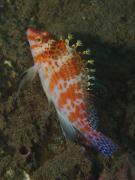Radio Program
Our regular Science and the SeaTM radio program presents marine science topics in an engaging two-minute story format. Our script writers gather ideas for the radio program from the University of Texas Marine Science Institute's researchers and from our very popular college class, Introduction to Oceanography, which we teach to hundreds of non-science majors at The University of Texas at Austin every year. Our radio programs are distributed at to commercial and public radio stations across the country.
A type of fish found off the southeastern coast of Australia isn’t much of a swimmer. Instead, it prefers to crawl along the ocean floor on fins that look a lot like hands. But its walking may be limited. It’s critically endangered, with populations dwindling in a hurry.
There are 14 species of handfish, although one of those hasn’t been seen in more than a decade. They live in rocky, sandy regions, generally at depths of a few dozen feet. They’re found mainly around the island of Tasmania.
People try to predict all kinds of things, from the weather to football scores -- all with mixed results. Predictions of one phenomenon are usually pretty accurate: the tides. But getting it right requires good information about many factors.
In January of 2013, at an auction in Tokyo, a sushi-restaurant owner paid one-and-three-quarter million dollars for a Pacific bluefin tuna. Not a boatload of them, mind you, but a single fish.
The high price was mainly a publicity stunt. Yet even an average bluefin typically sells for tens of thousands of dollars. That makes it one of the most expensive fish on the planet. And that’s making it increasingly endangered.
In July of 1969, a small submarine and its six-man crew got stuck. They didn’t run aground, though. Instead, they were caught in a swirling eddy in the Gulf Stream, the current of warm water that flows along the East Coast. The sub needed to surface so it could be towed back into the flow of the Gulf Stream.
Later, scientists discovered what caused the eddy: an underwater mound known as the Charleston Bump. It’s about a hundred miles off the coast of Charleston, South Carolina, on the edge of the continental shelf.
Seagrass beds provide a home for many species of fish. The fish can hide from predators in the blades of grass, and find food in the sand and mud on the bottom. But when the beds get thinner and patchier, the fish thin out, too -- there are fewer fish, and fewer species of fish. So it’s important to keep seagrass beds intact -- splitting them up is bad for the entire ecosystem.
You don’t need hurricanes, tropical storms, or nor’easters to get coastal flooding. It can happen in the middle of a sunny day, with not a storm cloud in sight.
These are known as “nuisance” floods. They occur around high tide, when the local sea level is at its highest. They don’t cause major damage, but they can make life inconvenient. They can cover roads, fill basements, kill lawns, and overwhelm storm drains. That costs time and money. And they’re becoming more common across almost the entire American coastline, especially the east.
There aren’t many worms that you could truthfully describe as “beautiful.” One of the few is found in the most colorful environments on Earth: coral reefs. It’s known as the Christmas tree worm because it looks like a colorful little fir tree. And it comes in an amazing variety of hues: red, blue, purple, yellow, and many others.
The colorful dwarf hawkfish has a colorful life story. Found on coral reefs from Australia to Japan, it lives in harems -- one large male with an entourage of several females. If the male gets greedy, though, things can change. One of the females can become a male and take half of the harem. And researchers recently found that if the new male is challenged by another male, he can change back to a female.
The hawkfish isn’t the only fish that can change sex. In fact, it’s a fairly common trait, especially among fish that live on reefs.
In July 1879, the USS Jeannette left San Francisco, headed for the north pole. No one had reached the pole yet, and scientists suspected it was ice free, with a ring of ice around it. Just two months later, though, the ship was frozen fast in the ice. It floated along for almost two years before the ice crushed it. Crewmembers then faced a long trek across sea and land that killed 20 of them -- only 13 survived.
Dolphins are among the “chattiest” creatures in the oceans. They use sound to find and catch food, as part of their courtship rituals, and just to stay in touch with other dolphins.
Many of those sounds are short clicks and high-pitched squeaks. And a team of researchers is using computers to pick out patterns of these sounds produced by different species of dolphins and whales.












